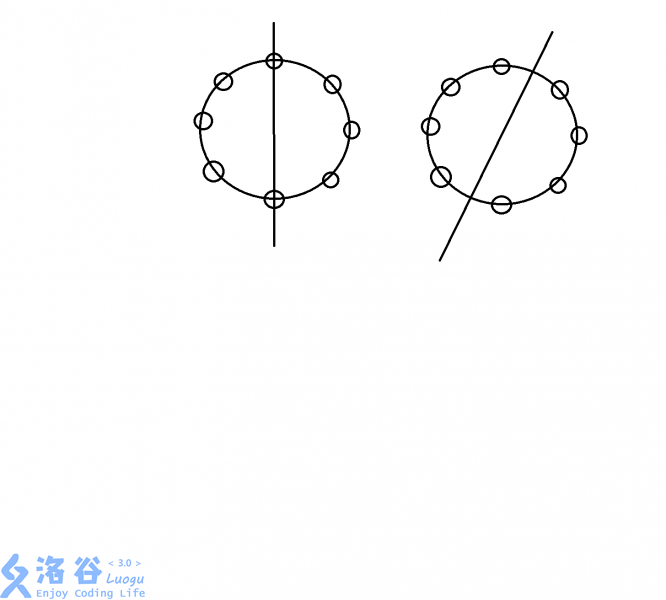poj1286–Necklace of Beads
标签:数学 置换 polya定理
题目描述
给出三种颜色红绿蓝,对一串n(n<24)个小球的环染色,环可以旋转和翻转,问最终可能有多少不同的染色方案。
输入输出格式
Input
The input has several lines, and each line contains the input data n.
-1 denotes the end of the input file.
Output
The output should contain the output data: Number of different forms, in each line correspondent to the input data.
输入输出样例
Sample Input
4
5
-1
Sample Output
21
39
题解
首先给出两个定理:
Burnside引理:
$$\frac{1}{\left | G \right |}\sum_{i=1}^{n}D(a_{i})$$
其中G表示置换种类(需要记住的是不变置换也算一种置换)
$D(a_{i})$表示在i置换下不动点的个数
Polya定理:
$$\frac{1}{\left | G \right |}\sum_{i=1}^{n}m^{c(g_{i})}$$
其中m表示染色种类,$c(g_{i})$表示在第i种置换下的循环节个数
这里有一个讲得比较好的文库可惜我没有下载券不能下载…
那么对于这道题来说要分两种情况:
1.旋转
对于旋转一共有0~n-1共n种置换,对于旋转i,它的循环节为gcd(n,i),这个可以找找规律发现,也可以通过证明:
假设每次增量为p,最少走了k步又回到原点:
则kp % n = 0 而 kp % p = 0且k为最少,故kp是n,p的最小公倍数,kp = lcm(n,p)
那么每次走了kp / p = lcm(n, p) / p = k步
那么一共走了n / (lcm(n,p)/ p) = np / lcm(n,p)= gcd(n,p)次
所以循环节是gcd(n,p)。
所以$Ans = Ans + \sum_{i=0}^{n-1}3^{gcd(n,i)}$
2.翻转
这里要分奇偶讨论:
(1)偶数
这里存在两种对称方式,如图:
一种是一条对称轴穿过两个点,此时有n/2种置换,对于每种置换有n/2 + 1个循环节
另一种是一条对称轴穿过两点之间,此时有n/2种置换,对于每种置换有n/2个循环节
(2)奇数
这里就只有一种对称方式了,选每个点作为对称点共有n中置换,对于每个置换有n/2 + 1个循环节
最后Ans除以G(2n中置换)即可
代码
#include<cstdio>
#include<cstring>
#include<cstdlib>
#include<algorithm>
#define ll long long
using namespace std;
int n;
int gcd(int a, int b) {return !b ? a : gcd(b, a % b);}
ll pow_mul(int a, int b)
{
ll ans = 1;
while(b)
{
if(b % 2) ans = ans * a;
a = a * a;
b >>= 1;
}
return ans;
}
int main()
{
while(scanf("%d", &n) && n >= 0)
{
ll ans = 0;
if(n == 0) {printf("0\n"); continue;}
for(int i = 0; i < n; i ++)
ans += pow_mul(3, gcd(n, i));
if(n % 2)
{
ans += pow_mul(3, n / 2 + 1) * n;
}
else
{
ans += pow_mul(3, n / 2) * (n / 2);
ans += pow_mul(3, n / 2 + 1) * (n / 2);
}
printf("%lld\n", ans / (2 * n));
}
return 0;
}
心得
运用polya定理主要是找出循环节,但是值得注意的是,polya定理不能受到颜色数量的限制,否则只能用Burnside引理,而且注意要包括不变置换。
![[HNOI2008]Cards](http://pvujsoqjl.bkt.clouddn.com/MN2deerstalker.png)
![[CQOI2015]选数](http://pvujsoqjl.bkt.clouddn.com/MN05wickedfate.png)